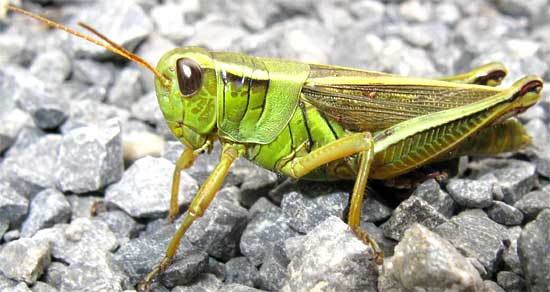- oversized back legs used for jumping
- large compound eyes
- fairly large size
- it's fluttery way of flying short distances
- often grasshoppers make pops or snaps when they fly
THE GRASSHOPPER LIFE CYCLE
When a female grasshopper is ready to lay her eggs, there's hardly anyplace better for her to go than an open, sunny field. She needs soil to be loose enough for her to work her rear end into it. Once her rear end is well underground, while she is laying her eggs, a frothy, gluelike substance is deposited over them. This substance hardens around the eggs as it dries. The frothy mass, which can be called an egg pod, dries into something like a stiff sponge, so that when the eggs hatch there'll be plenty of air for the newborn, and it won't be too hard for the newborn to escape. The number of eggs in a pod varies from individual to individual, and species to species -- maybe as few as six or so, or more than 150. Each female deposits several pods. Some species, instead of laying in pods, just cram them haphazardly here and there in the ground.
So, when young grasshoppers emerge from their eggs, they find themselves inside a honeycombed egg pod, and buried underground. They must push their delicate bodies upward through the soil, especially using their long back legs. During this process their bodies are covered by a membranous hatching skin, which to some degree both protects the body's delicate parts, but also restricts movements of the legs, making it even harder to push upward.
At the ground's surface, the hatching skin comes off, giving the legs full mobility. Grasshoppers undergo simple metamorphosis, so immature grasshoppers look more or less like adults, only smaller and with undeveloped wings. As nymphs grow, they molt several times, shedding their "skins," or exoskeletons. As with other insects who undergo simple metamorphosis, each progressive stage of nymph development is referred to as an "instar," so we might speak of a 2nd instar grasshopper or a 4th instar one. The final molting results in a full-size adult with wings. Though it varies with species, five or six instar stages usually take place. The time from egg to adult typically is 40 to 60 days. That's probably a 5th instar nymph in the picture below:

The above grasshopper is clearly a nymph because its wings are so short. The wing is the oval, finely pitted item appearing to issue from beneath the cape-like "back shield," or prothorax. On an adult grasshopper the wings would project well beyond the abdomen's rear end, but you can see that on this nymph it reaches much less than that distance.
GRASSHOPPER CLASSIFICATION
Grasshoppers belong to the insect order Orthoptera, which also holds katydids, crickets, mantids, walkingsticks and cockroaches.
But, thing is, when you look at all the kinds of grasshoppers in the world along with all known grasshopper relatives, it becomes hard to decide where grasshoppers end and other insects, such as crickets and katydids, begin and end. According to the Peterson Field Guide A Field Guide to the Insects, here is one breakdown of the different kinds of grasshoppers found in North America:
found in North America
- Short-horned Grasshoppers, family Acrididae
- Long-horned Grasshoppers, family Tettigoniidae
- Cone-headed Grasshoppers, subfamily Copiphorinae
- Meadow Grasshoppers, subfamily Conocephalinae
- Shield-backed Grasshoppers, subfamily Decticinae
- Pygmy Grasshoppers, family Tetrigidae
- Monkey Grasshoppers, family Tanaoceridae
- Eumastacid Grasshopper, family Eumastacidae
Other field guides group them a little differently, plus some experts would refer to our "Meadow Grasshoppers" as "Meadow Katydids," and make other similar name changes. The truth is that there's no point to debate what's a grasshopper and what's not. The word "grasshopper" is standard English, but it has very little if any scientific value.
If you'd like to see the current breakdown of families and subfamilies in the Orthoptera, showing how grasshoppers mix in with crickets, katydids and the rest, check on the NCBI Taxonomy Browser's Orthoptera Page.
LOCUSTS
You've probably heard of plagues of locusts and how sometimes vast clouds of them darken the sky. Locusts are grasshoppers. You may be interested in Naturalist Jim's field notes and pictures of locusts in Mexico.

